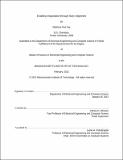| dc.contributor.advisor | Patrick H. Winston. | en_US |
| dc.contributor.author | Fay, Matthew Paul | en_US |
| dc.contributor.other | Massachusetts Institute of Technology. Dept. of Electrical Engineering and Computer Science. | en_US |
| dc.date.accessioned | 2012-07-02T14:20:06Z | |
| dc.date.available | 2012-07-02T14:20:06Z | |
| dc.date.copyright | 2012 | en_US |
| dc.date.issued | 2012 | en_US |
| dc.identifier.uri | http://hdl.handle.net/1721.1/71281 | |
| dc.description | Thesis (S.M.)--Massachusetts Institute of Technology, Dept. of Electrical Engineering and Computer Science, 2012. | en_US |
| dc.description | This electronic version was submitted by the student author. The certified thesis is available in the Institute Archives and Special Collections. | en_US |
| dc.description | Cataloged from student submitted PDF version of thesis. | en_US |
| dc.description | Includes bibliographical references (p. 81-82). | en_US |
| dc.description.abstract | Stories are an essential piece of human intelligence. They exist in countless forms and varieties seamlessly integrated into every facet of our lives. Stories fuel human understanding and our explanations of the world. Narrative acts as a Swiss army knife, simultaneously facilitating the transfer of knowledge, culture and beliefs while also powering our high level mental faculties. If we are to develop artificial intelligence with the cognitive capacities of humans, our systems must not only be able to understand stories but also to incorporate them into the thought process as humans do. In order to work towards the goal of computational story understanding, I developed a novel story comparison method. The techniques I present in this thesis enable efficient and effective story comparison through story alignment. My algorithms, implemented into the Genesis system, allow the comparison and combination of stories which is a step towards enabling imagination in artificial intelligence. This capability is made possible by reducing the runtime of a previously intractable computational problem to polynomial time. In the course of this research, these algorithms have been applied to a variety of story analysis problems. By comparing short, 10 sentence summaries of the Tet Offensive and the Yom Kippur War, the system predicts information omitted from both stories. In the analysis of a brief synopsis of Shakespeare's Macbeth, my algorithm is able to correctly match actors and events between two different variations of the tale by cutting down a search space of over 10³⁰ nodes to a mere 546 nodes. My techniques also demonstrate promise as a component of a larger video analysis system. The story alignment capabilities are used to fill in missing gaps in descriptions of videos, corresponding to missing video data, by comparing video feeds to an existing video corpus. | en_US |
| dc.description.statementofresponsibility | by Matthew Paul Fay. | en_US |
| dc.format.extent | 82 p. | en_US |
| dc.language.iso | eng | en_US |
| dc.publisher | Massachusetts Institute of Technology | en_US |
| dc.rights | M.I.T. theses are protected by
copyright. They may be viewed from this source for any purpose, but
reproduction or distribution in any format is prohibited without written
permission. See provided URL for inquiries about permission. | en_US |
| dc.rights.uri | http://dspace.mit.edu/handle/1721.1/7582 | en_US |
| dc.subject | Electrical Engineering and Computer Science. | en_US |
| dc.title | Enabling imagination through story alignment | en_US |
| dc.type | Thesis | en_US |
| dc.description.degree | S.M. | en_US |
| dc.contributor.department | Massachusetts Institute of Technology. Department of Electrical Engineering and Computer Science | |
| dc.identifier.oclc | 796392185 | en_US |
